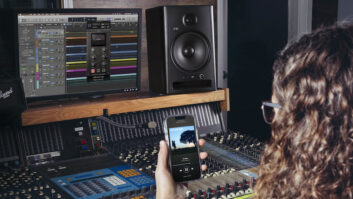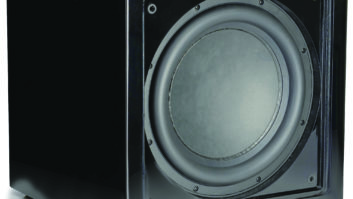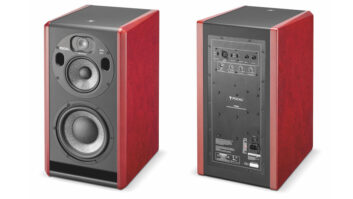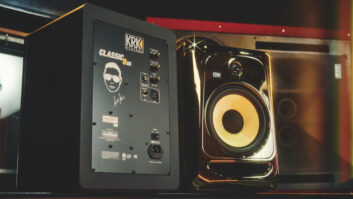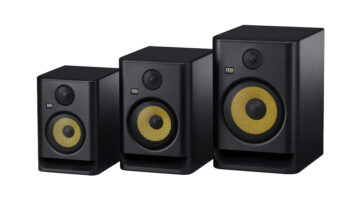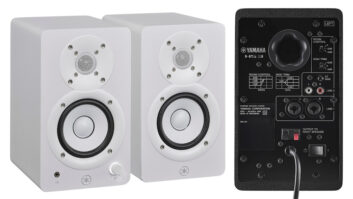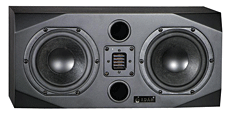
The ADAM P33A speakers are a downsized version of the company’s popular S3A speaker and are aimed at near/mid-field monitoring applications, where powerful yet smaller boxes are required. The P33A uses ADAM’s A.R.T.-design ribbon tweeter and dual 7.5-inch woofer deployment — all driven by three built-in amplifiers. Similar to the dual-woofer design in the larger S3A, one woofer functions as a full-range driver while the second one is active only at frequencies below 150 Hz. According to the company, this effectively doubles the woofer’s area and power when it needs to respond to deeper frequencies, resulting in better low end without compromising midrange performance.
POWERING UP
The tri-amped (3x 100W/channel), shielded self-powered speakers are sold as a matched pair with left to right (A/B) orientation — critical for proper imaging. The P33As are designed to work either horizontally or vertically, with the two woofers on each side and the ribbon tweeter in the middle. When they are set up (preferably on a solid, rigid surface), the full-range woofers should be mirror images of each other. I went with the suggested horizontal A/B setup at my studio, but during one cramped remote session, I used them vertically. The overall imaging did not suffer any major problems; they were quite usable and just as detailed.
A subtle but easily visible green LED embedded in the ribbon tweeter baffle lets you know the power is on and the speakers are active. Although all trim pot settings are shipped in Flat mode from the factory, tweekers can easily make adjustments for room variables.
In addition to the rear power switch and balanced XLR input, there are four recessed continuous trim pots for input gain, high and low room EQ, and an additional high-gain control.
The input trim pot offers ±10 dB of boost or cut, useful for matching amp outputs and L/R alignment. The high-gain trim pot controls overall tweeter level, with ±4 dB of gain change available. It’s recommended that this control be left flat, but for overly damped or larger rooms, this is a handy feature to have. Two room EQ controls are also included, with ±3dB gain change for shelving points starting at 150 Hz (low) and 6 kHz (high). As I used the SP33s on a variety of location and studio applications, I found the low-frequency trim adjustment convenient when working without a sub. (It is nice to know what’s going on down there, and once you understand what the added or reduced bass means to the mix, you can adjust accordingly.)
IN MY EAR
Straight out of the box with the controls set to Flat, the P33As required little adjustment, but it was nice to have the trim options. The A.R.T. tweeters are the centerpiece of the P33As’ design, and you’ll either love them or hate them, depending on your taste in high-end dispersion devices. Similar to other monitors in this price range, the mono imaging was superb and held up solidly, both up-close and as far as four to five feet back in the control room.
I used the P33As on many projects, from location recording to in-studio tracking and got some exciting, useful, yet occasionally uneven results. The unevenness was specifically noticeable in the upper mids and top end, as compared to the Lipinskis and my associate’s B&Ws. And just like all of them, they need a sub if you want the whole sonic picture. However, they are robust and powerful enough for any kind of day-to-day tracking work. If you’ve got slamming bass and drum with lots of guitar and vocal overdubs, then they will certainly deliver.
The monitors took everything I threw at them, effortlessly handling low and upper-midrange jabs without flinching or sagging. The tweeter is more of an acquired taste, and though I prefer a silkier, smoother sound, the tweeter didn’t let me down and wasn’t smeary during loud sessions with crashing cymbals and sparkly percussion. Vocals were crisp and clear — not strident or fatiguing.
While there’s enough low bass and punch to get by without a subwoofer, I always prefer to work with one. Still, the monitors gave me plenty of good information and clues to know what I was hearing without a sub during location tracking sessions. The P33As were rock-solid with kick drum and electric and acoustic basses. I dislike hearing amp power droop and sag with poorly designed self-powered speakers, but the P33As’ tri-amp design packs plenty of transient power (150W/peak) to keep things vital.
SWEETNESS ALL AROUND
There was a much wider and deeper sweet spot than I’m accustomed to with control room monitors of this size. This came in handy when dealing with groups of four or more musicians crowded into the control room for reality checks and quick playbacks. No one got a skewed or isolated portion of the sound; when working with “more me in the mix” types, this is a real blessing.
Though a bit exaggerated, the wide stereo imaging lets you get inside the sound field — even as far back as five or six feet — when overdubbing and layering tracks. While the horizontal setup was obviously the wider and more pronounced sound field, I liked the vertical setup for other uses such as remote work. The vertical arrangement let me concentrate on the overall sound as opposed to the stereo imagining when working alone on location.
If you’re looking for a powerful, robust self-powered near-field monitor with a big sound for your mid-sized studio, make sure you check out the P33As. They may be just what your sonic sweet tooth needs.
Price: $3,200/pair.
ADAM Audio, 805/413-1133, www.adam-audio.com.
Joe Hannigan runs Weston Sound & Video in Philadelphia.
